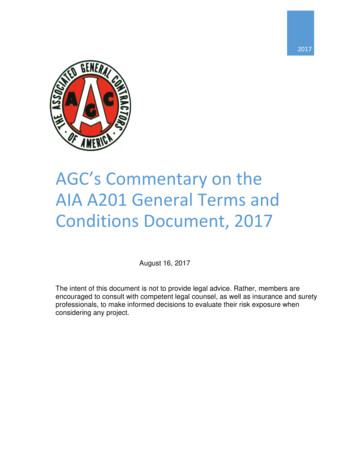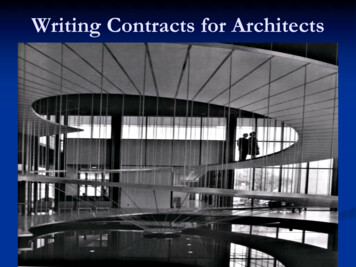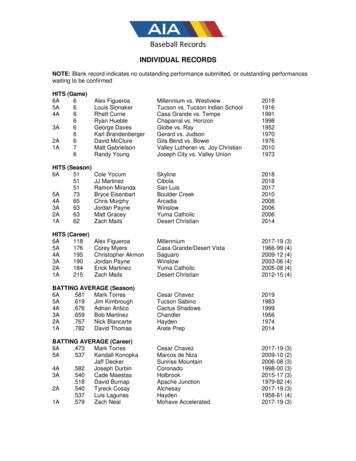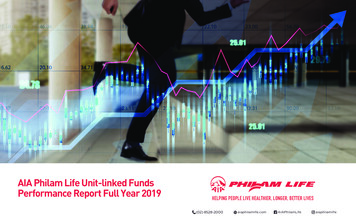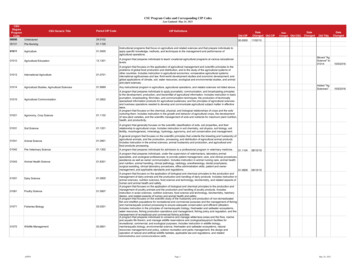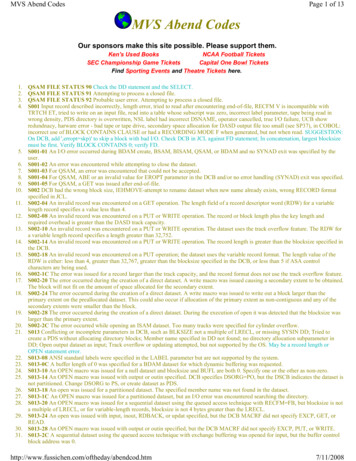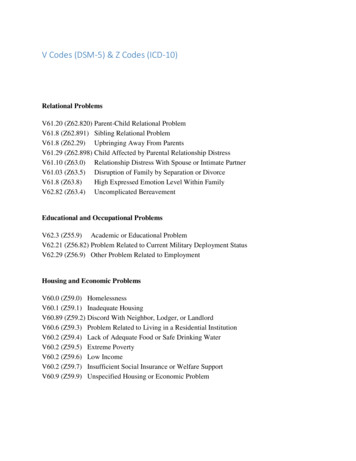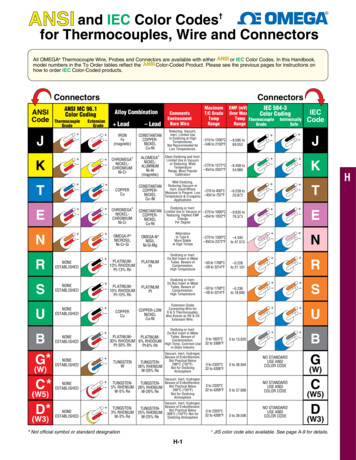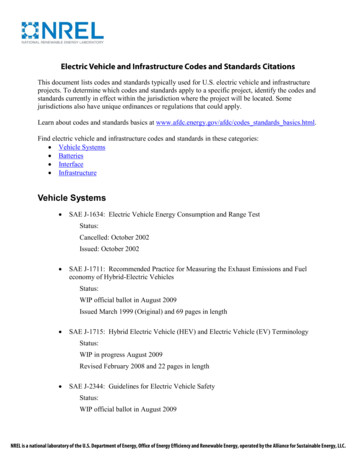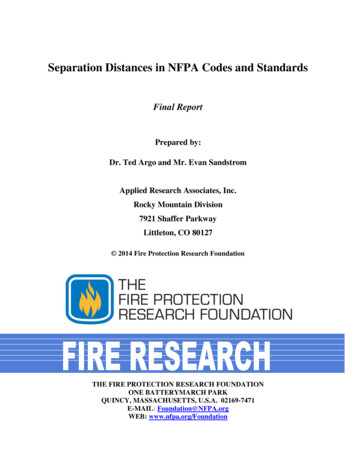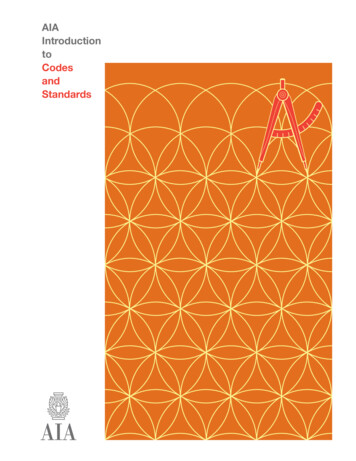
Transcription
AIAIntroductiontoCodesandStandards
PrefaceJJust as construction practices have evolved over time, sohave the regulations that govern the design, construction,and occupation of the built environment. With fewexceptions, these regulations—our building codes—donot become less stringent over time, and many elementsthat used to be considered as best practices are nowcodified as minimally acceptable construction practices.Under new, higher performance codes, design professionals responsible for incorporating code requirements intothe design process are subject to new expectations andlegal requirements.Architects are typically the responsible design profession-als, with a corresponding duty to protect the health, safety,and welfare of both building occupants and the public at2AIA Introduction to Codes and Standards
large. As a group, architects may be the most significantlyaffected by, and the most significant users of, the codes.The American Institute of Architects (AIA) representsthe profession on these important issues by supportingmember architects’ participation in code developmentand adoption processes.The AIA Codes and Standards Committee, building uponthe work of its predecessor, the Building Performanceand Regulation Committee, has produced this documentas an introduction to the world of codes and standards,to help architects better understand current developmentprocesses for the national model codes. It providesinformation on the historical and current developmentprocesses used by model codes and standardsorganizations. This information will increase architects’understanding of the subject and encourage their participation in the development of future codes and standards.There has been tremendous growth in the number ofbuilding design and construction regulations over the lastninety years. There have also been remarkable changesin the number and identity of organizations that developthe model codes and standards. To many architects, thevarious acronyms, procedures, and requirements formembership associated with these organizations areconfusing and complex. It is nonetheless vital thatarchitects understand the work of these organizations,3AIA Introduction to Codes and Standards
because these groups shape the codes with whichbuilding projects must legally comply.The AIA is in the fortunate position of being able to drawupon the expertise of every type of practitioner in theprofession. It is composed of a diverse populationcovering large and small firms, emerging and seasonedprofessionals, and both urban and rural practices. Itrepresents architects specializing in all project types, fromsingle-room additions to stadiums, retail shops to airports.Many members have expertise in multiple disciplines,including structures, interiors, retail, and landscapedesign, to name just a few. Thisdiversity of practice translates intomany different but complementaryviewpoints, which the AIA brings tomodel code development. Regardlessof practice area, it is important that themodel codes reflect the best interestof the general public, as well as carefulconsideration of the role of the designprofessional. To that end, the AIA hasestablished public policies on codesand standards, to assure the designand construction of safe, sustainablebuildings and communities, while alsopromoting the professional practice ofarchitecture.4AIA Introduction to Codes and Standards
AIA Position StatementsPosition Statement 22—Building Codes and StandardsPosition Statement 23—Building PermitsPosition Statement 44—Sustainable Building Codes, Standards andRating SystemsOne CodeAmong the AIA’s public policies on codes and standards is the “one code” policy,which states:The AIA supports regulation by a single set of comprehensive, coordinated, and contemporary codes and standards, which establish soundthreshold values of health, safety, and the protection of the publicwelfare throughout the United States. To that end, the AIA espousesthe development and adoption of model building codes that:nInclude participation by architects and the public in a consensus process;nAre the product of informed education and research;5AIA Introduction to Codes and Standards
nAre without favoritism or bias to any special interest;Include provisions for a prompt appeals procedure for all that might beaggrieved;nnAre cost-effective in relation to public benefit; andPromote building code provisions that set performance rather thanprescriptive criteria.nThe AIA plays a critical role in the development of the International Code Council’s(ICC) family of codes, the most widely adopted set of model codes in the nation.As the professionals with the most synthetic view of the wide range of factors thatgo into a building project, architects are uniquely capable of identifying and helpingto resolve internal conflicts and overlaps that remain among the several individualcodes that are adopted by jurisdictions. As the ICC moves toward a staggeredcode development cycle for various codes, such redundancies and conflicts canmultiply. The AIA will continue to support the simplification and coordination ofmodel codes and standards, even as technological advancement and heightenedaspirations tend toward greater complexity.Most jurisdictions base their building codes on model codes, developed by anorganization such as the International Code Council, through a formal, consensusbased process incorporating the expertise of numerous stakeholder groups; andrevised on a regular, three-year cycle. Typically, the jurisdiction will amend themodel code to take into account local climate and resource conservation, regionalconstruction practices, and the like. As the professionals who apply the codes indesign, architects can and should be trusted resources to their community leadersto advise them during the code adoption process.HistoryBuilding codes in the United States developed over many years in response to thedesire to protect life and property from fire, wind, earthquake, and other forces. Inthe 19th and 20th centuries, the insurance industry played a large role in pressuringgovernments to regulate the occupancy and use of buildings in order to protectagainst loss. Several key events marked major changes to the codes, notably the1903 Iroquois Theater fire in Chicago, which claimed 602 lives, and the 1942 fireat Cocoanut Grove Nightclub in Boston, which claimed 492 lives. Both tragediesbrought about new code requirements across the country, such as use of panichardware and outward-opening doors, along with increased attention to codeenforcement in existing buildings.While individual cities and states developed their own building codes, over timethese have been largely superseded by national model codes, adopted withregional or local modifications by individual jurisdictions. In the 1970s, the AIA6AIA Introduction to Codes and Standards
began advocating for a single code based on combining the three existing regionalcode writing groups: the Building Officials and Code Administrators (BOCA); theInternational Conference of Building Officials (ICBO); and the Southern BuildingCode Congress International (SBCCI). These three groups eventually dissolved andformed the International Code Council (ICC) in the late 1990s. The ICC “family” ofcodes is now the prevailing model for jurisdictions throughout the United States.The ICC, like most publishers of codes and standards, develops model codesthrough a “consensus process.” The ICC’s governmental consensus processaligns with federal guidelines for voluntary consensus standards (Office ofManagement and Budget Circular A-119) as well as AIA’s Codes Policy, andincludes the following concepts:Open Public ForumsnAll forums are open to the public at no costnAnyone can submit a code change proposal and testify at the hearingsnAll views are considered by the code committees prior to a voteDecision TransparencyAll testimony and committee recommendations are made in open publichearingsnAll final code change proposal decisions are made by public safety officialsin a public hearingn7AIA Introduction to Codes and Standards
Representation of InterestsnWide-ranging representationnFull disclosure of conflicts of interestOne-third of the committee’s members must be governmental memberswith no financial vested interestsnnMembership on a committee is not conditional on membership in ICCDue ProcessnEqual opportunities for rebuttalCommittees consider all views, objections, and the cost impact of all codechange proposalsnnAll who attend can testifyAppeals ProcessnOpen appeal processnAppeals considered per due processMajority ConsensusA simple majority from the committee decides the action of the proposedcode changennICC assembly action allows members to challenge the action of the committeeThe ICC publishes their process for modifying and adopting changes to theirpublished codes. It outlines the rules for timely evaluation and recognition oftechnological developments pertaining to construction regulations.InfluencersMany people and organizations with diverse perspectives influence the formationof building codes. They include building and fire officials, engineers, architects,building owners, product manufacturers, federal government agencies, regulators, contractors, labor organizations, facility managers, specifiers, commissioningagents, city managers, planners, other public officials, and funding agencies.8AIA Introduction to Codes and Standards
Codes, Standards, and Rating SystemsTo effectively navigate the landscape of building regulation, it is necessary tounderstand the differences among the three most commonly encountered typesof documents: codes, standards, and rating systems.A building code is an enforceable body of rules that governs the design, construction, alteration, and repair of buildings. It establishes minimum requirements that abuilding must meet, with the intention of protecting the health, safety, and welfareof occupants and neighbors. The enforcement of the building codes varies fromjurisdiction to jurisdiction. In some states, a state building code establishes minimum requirements that the state enforces; others allow enforcement by local jurisdictions, which can’t opt out of the requirements. In yet others, the local jurisdictioncan make those requirements more stringent, but not less; and finally, in others,local jurisdictions are solely responsible for enacting and enforcing building codes.A building standard defines a specific way—or a variety of alternative ways—to achieve a desired outcome. Standards are typically developed by independentorganizations through a consensus-based process. These organizations fall intotwo categories: independent testing agencies, such as Underwriters Laboratory(UL); or member groups setting a standard of care for their members and givingguidance to those outside their membership, such as the American Society ofHeating, Refrigerating and Air-Conditioning Engineers (ASHRAE) and ASTM9AIA Introduction to Codes and Standards
International (formerly known as American Society of Testing and Materials). Eachhas its own schedule and process for modifying its standards, typically based onthe ANSI (American National Standards Institute) criteria. Such groups may or maynot be certified by ANSI. A standard may serve simply as a yardstick of commonlyaccepted practice, or, if it provides the necessary level of specificity, it may beincorporated by reference into a code and becomes enforceable.Historically, rating systems, such as those for the fire-resisting properties ofmaterials, have established terms of measurement for the performance of building components. Such rating systems are often referenced in building codes toestablish minimum requirements for a component’s performance. Independentbodies test and rate materials, products, or assemblies and certify their level ofperformance per the referenced standard, to determine if they are acceptable inthe marketplace.More recently, green building rating systems, such as the USGBC’s LEED, haveemerged for the purpose of rating the overall performance of buildings withrespect to energy consumption, resource conservation, indoor air quality, andother environmental considerations. Such rating systems are intended toencourage levels of performance above and beyond the minimum requirementsset by codes; their language is not necessarily crafted with enforceability as aparamount concern. Consequently, when incorporated by reference into a building code, a rating system may present challenges in interpretation, documentation,and enforcement. In addition, the process of review and revision of the ratingsystem itself may not follow a recognized consensus process nor a regular, threeyear cycle of the model codes, thus complicating the process of keeping thebuilding code up-to-date at the local level.Prescriptive vs. Performance LanguageAny provision of a code, standard, or rating system may be defined prescriptivelyor in terms of performance. A prescriptive provision states precisely what must bedone, e.g., “must be attached with 10d nails at 6 inches on center.” A performanceprovision sets a minimum requirement for how the component performs—e.g.,“must be able to sustain a lateral point load of 200 lbs.”—without prescribing howthat minimum level of performance is to be accomplished. Most model codes offerboth prescriptive and performance options.EnforcementIn addition to the traditional building departments and other local or stateauthorities having jurisdiction, , some federal agencies, including the OccupationalSafety and Health Administration (OSHA), the Environmental Protection Agency10AIA Introduction to Codes and Standards
(EPA), and the Departments of Energy (DOE), Housing and Urban Development(HUD), the Interior (DOI), and Justice (DOJ), exercise various forms of control overbuilding construction. Local building officials do not enforce federal regulations.Compliance processes are independent of local authority and take various forms.Accessibility under the Americans with Disabilities Act is a civil right enforceable bythe Department of Justice. Compliance, if challenged, is determined by the courtsafter the project is completed. In addition, recent federal programs, such as theEnergy Information and Security Act and the American Recovery and Reinvestment Act’s (ARRA) incentives to states, have had a direct effect on adoption ofcodes and standards.A Special Case: the IgCCFor an in-depth discussion of the IgCC, see The AIA Guide to the IgCC. The Guideprovides an overview of the 2012 IgCC with respect to potential impacts on designand the practice of architecture.Developmentof the IgCCRecently, the AIA has enjoyed an opportunity to participate in the development ofthe first national model green code. AIArecommended members to participateon both the drafting and the codedevelopment committees appointed bythe International Code Council (ICC).Because architects have a unique andvital perspective in the development ofthe IgCC, it is a priority of the AIA Codesand Standards Committee and the AIANational Board of Directors that ourperspective continue to shape the futureof the new code. The development ofgreen model codes brings changes to thepractice of architecture, and the profession must understand those changes toact as industry leaders. The architect mustbe prepared to work with the new codein order to protect the health, safety, andwelfare of the general public and bringadded value to their clients.11AIA Introduction to Codes and Standards
Evolution of Green CodesArchitects have long been trained in sustainable design and construction.In 2005, the AIA adopted several position statements relating to the importanceof sustainable design to the profession and society. For over ten years, greenbuilding rating systems such as LEED, BREEAM, and others achieved marketplacesuccess by formulating a set of prescriptive approaches and conventions.Energy-oriented codes such as the ICC’s International Energy ConservationCode (IECC), or standards such as ASHRAE’s 90.1.2007 or 189.1, promoteapplication of sustainable and energy efficient design practices.The movement of rating systems from marketplace devices to policy instrumentshas impacted the work of architects over the past ten years, as the rating ofgreen buildings has grown in popularity. The adoption of a “stretch” code inMassachusetts, a “reach” code in Oregon, and Title 24 and CALGreen in Californiahave all moved the energy-use reduction and sustainable building factors into theregulatory arena of the building code. The launch of the IgCC in 2012 expands theapplicability of a sustainable building code to a national level, as jurisdictions adoptthis new code. The IgCC incorporates new requirements, which will engage morecritically architects’ skills and working methods.One of the most significant characteristics of the IgCC is its emphasis on buildingperformance as one of several paths to compliance. The IECC, ASHRAE 90.1and now the IgCC require that buildings target performance based on a calculationof projected energy use, rather than prescriptively defining the design features ofa building.Advanced codes afford the practicing architect a number of potential methods forproviding added value to their clients. Addressing code related issues, especiallyin light of high-performance codes, can be a part of a business strategy for firmsand sole practitioners alike. Services such as energy modeling and commissioningare opportunities for an expanded practice under the IECC (International EnergyConservation Code) and the IgCC.Outcome-Based CodesAnother idea growing in popularity among state and local level policymakers isthe notion of outcome-based codes, which assess project compliance based onactual performance, measured after the completion of construction. While this isnot yet a feature of typical code regimes, the groundwork has been laid in stateswith state-specific green codes: California (Title 24), Massachusetts, Oregon,and Washington. The City of Seattle is working with the National Trust for HistoricPreservation Green Lab on outcome-based codes that work with existing and12AIA Introduction to Codes and Standards
historic structures. In Vancouver, British Columbia, the comprehensive BuildSmartprogram includes the use of green bonds and mandatory disclosure for years afterissuance of a certificate of occupancy.The increased interest in disclosure regulation, requiring building owners toprovide performance data from the operation of their buildings, suggests that thiswill be an important trend for architects to consider as they design energy efficientbuildings for clients. New York City has passed regulation mandating publicdisclosure of buildings’ energy use.Ultimately, the trend toward a regulatory environment in which building codesemphasize energy performance and sustainability presents an opportunity forarchitects to apply their professional expertise to decision making on communityhealth, economic factors, and planning and development at a larger scale, andto provide greater professional influence over the impact of buildings on theindividual and the community.This evolution of model codes also applies in some part to the development of theICC itself. That effort was due in no small part to Bob Fowler, FAIA, President ofICBO at the time. The criteria that were used to develop the IgCC applied equallyto the creation of the ICC. That change is arguably more critical to the health ofcodes from the architects perspective than the IgCC.13AIA Introduction to Codes and Standards
Code EducationBuilding codes evolve constantly to ensure a community’s health, safety, andwelfare in the face of new technology and changing risk awareness. The expertiserequired to develop architectural designs that comply with rapidly changing codesand regulations is constantly increasing. The AIA is a natural focal point to provideaccess to the education required to ensure that architects remain current in theirknowledge and application of building codes. Code education provided by theAIA includes an all-day design workshop and two 90-minute sessions that give anoverview of the concepts presented.Code Development: Getting InvolvedArchitects make a difference in shaping building codes by helping to simplifylanguage and to craft that language to promote resource-efficient building performance. The architect’s integrated understanding of all of the factors that shape abuilding is essential for the crafting of codes purged of redundancy, ambiguity, andcontradictions.Our collective experience at the code development table illustrates the importanceof architects’ involvement in the code development process. Architects involved inthe development of the codes have kept the interest of all our members in the forefront of the discussions and the development of the codes and their concepts andlanguage. Without the architect’s presence, the codes would be much different.There are several ways for individual architects to get involved:nContact the AIA Codes Advocacy Team and let us know you’re interested.Join and post comments to AIA’s KnowledgeNet site for Codes and Standards,the LinkedIN AIA Codes and Standards Group, and add to or start your owndiscussion threads on codes and standards issues.nVolunteer at the local chapter level, join or start a Codes and StandardsCommittee, and keep AIA National involved in your efforts, so we can all benefit.nRespond to opportunities for public comment to code changes directly to thecode or standard developing agency (ICC, ASHRAE, etc.) or by contacting the AIACodes and Standards Committee or the Codes Advocacy Team.nArchitects must continue to maintain our stake in the development of modelcodes in order to ensure that our best interests, as well as those of the public,are protected and that reasonable standards of care are promoted. In other words:let’s not leave to non-architects the writing of the rules under which architectspractice. Get involved!14AIA Introduction to Codes and Standards
2012 AIA Codes and Standards CommitteeKatia Thomas Burgin, AIA, LEED AP, RNL DesignRon Burton, PTW Advisors, LLCDavid S. Collins, FAIA, Preview Group, Inc.Kevin J. Flynn, FAIA, Kiku Obata & CompanyMaureen A. Guttman, AIA, Alliance To Save Energy/BCAPErin Rae Hoffer, AIA, Autodesk, Inc.Caryl Kinsey, AIA, Caryl A. KinseyWhitney E. Okon, Assoc. AIA, Applied Building Sciences, IncSteven R. Winkel, FAIA, The Preview GroupCommittee ChairLead AIA Code ConsultantAIA National StaffJessyca Henderson, AIA—Managing Director, Policy and Community RelationsStephanie Spear, Esq—Manager, Codes AdvocacyOnline cacy15AIA Introduction to Codes and Standards
6 AIA Introduction to Codes and Standards n Are without favoritism or bias to any special interest; n Include provisions for a prompt appeals procedure for all that might be aggrieved; n Are cost-effective in relation to public benefit; and n Promote building code provisions that set performance rather than prescriptive criteria. Th
